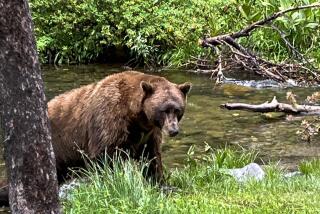U.S. is close to listing polar bears as threatened
The Bush administration is nearing a decision that would officially acknowledge the environmental damage of global warming, and name its first potential victim: the polar bear.
The Interior Department may act as soon as this week on its year-old proposal to make the polar bear the first species to be listed as threatened with extinction because of melting ice due to a warming planet.
Both sides agree that conservationists finally have the poster species they have sought to use the Endangered Species Act as a lever to force federal limits on the greenhouse gases linked to global warming, and possibly to battle smokestack industry projects far from the Arctic.
“All animals are equal, but some animals are more equal than others,” said Kassie Siegel, an attorney with the nonprofit Center for Biological Diversity. “And then there is the polar bear.”
Even Frank Luntz, the political consultant who advised President Bush six years ago to focus on discrediting the science of global warming and refer to it as “climate change,” has recognized the bear’s potency. In an interview on the environmental website Grist.org, he said the public has a “soft side” for the bear.
Federal government scientists have presented increasingly compelling evidence that the top predator at the top of the world is doomed if the polar regions get warmer and sea ice continues to melt as forecast.
Two-thirds of the population could be gone by mid-century if current trends continue, experts say. Bears are beholden to sea ice, where they perch so they can pounce on unsuspecting seals, their primary food.
Images pop up regularly of scrawny, exhausted bears dragging themselves onto ice floes looking like bones covered in sodden white rugs. So do reports of struggling bears swimming wearily in open water. It’s a shocking contrast to the pop-culture image: smiling animated bears guzzling Coca-Cola in commercials, fat lounging bears drawing crowds at zoos or fluffy Polyester stand-ins adorning children’s bedrooms.
“These are soft and cuddly, giving bears,” said Anthony Leiserowitz, a public opinion researcher and director of the Yale Project on Climate Change. “We give them to each other on Valentine’s Day and tuck them in with our children at night.”
Charismatic creature
All this humanizing of the ferocious carnivore makes conservationists believe they have found the charismatic mega-fauna needed to transform the issue of global warming from a distant abstraction into something real, accessible and urgent.
The script calls for the big white bear to play a role similar to that of the American bald eagle in the 1970s, which was at center stage in the nascent environmental movement to tighten pesticide regulations and ban the insecticide DDT.
Conservationists hope the bear will focus the nation on curtailing carbon dioxide and other greenhouse gases blamed for melting ice and other symptoms of a warming planet. They are eager to press this case in court; oil and gas industries and their allies fear it.
Heavy industry has reason to fear. At least one part of the environmental community believes the bear’s listing would provide the leverage to stop a coal-fired power plant thousands of miles away from the Arctic.
Sen. Jim Inhofe (R-Okla.), who is known for his skepticism about global-warming measures, asked U.S. Fish and Wildlife Service Director H. Dale Hall last week whether listing the polar bear could be used to halt the construction of a new power plant in Oklahoma City.
“The Endangered Species Act is not the vehicle to reach out and demand all of the things that need to happen to address climate change,” Hall said, to Inhofe’s apparent satisfaction.
Andrew E. Wetzler, director of the Natural Resources Defense Council’s endangered species project, said Hall misunderstands the legal principles underlying the act, which was fortified by a recent U.S. Supreme Court ruling that carbon dioxide can be regulated as a pollutant.
If the builders of a coal-fired plant needed a federal permit, they would probably have to show how its emissions would not erode the polar bear’s habitat or jeopardize its survival, Wetzler said.
Several conservation groups have filed a lawsuit and threatened a second one to force the listing of the bear. Already, they have sued to nullify oil exploration leases in the Chukchi Sea, set for sale Wednesday, arguing that the bear’s plight got short shrift during environmental reviews.
‘Mother of all test cases’
Meanwhile, opposing forces representing the oil and gas industry, manufacturing and property-rights advocates have begun threatening counter-suits over the potential listing.
“This is going to be the mother of all test cases,” said Alison Rieser, a lawyer and ocean policy professor at the University of Hawaii. “The legal question is whether the emissions of a proposed power plant can be tied to the cumulative effect of carbon dioxide, which is adversely affecting sea ice -- critical polar bear habitat.”
Sea ice has been receding for three decades, leaving ever-expanding gaps that have forced bears into long, sometimes fatal swims. An aerial survey in 2004 found dead bears floating in the open sea off Alaska’s north coast.
Scientists believe the global population of 20,000 to 25,000 polar bears is relatively robust, although they don’t know much about bears in Russia and other remote Arctic places.
Unusually big melt
A well-studied population, located in Canada’s western Hudson Bay, has dropped by 22% since 1987. The ice there breaks up an average of three weeks earlier than it did 30 years ago, giving polar bears there less time to hunt and build up fat reserves that sustain them until hunting resumes in the fall. As bears have become thinner, female bears’ reproductive rates and the survival rates of cubs have fallen.
Such evidence persuaded the Fish and Wildlife Service more than a year ago to propose listing the polar bear as threatened with extinction because of vanishing ice.
Then last summer, an unusually big melt surprised most climate modelers, who had not forecast such a dramatic decline so soon. In September, the U.S. Geological Survey released a set of comprehensive studies that analyzed existing climate models and came up with a dire forecast: The habitat of two-thirds of the bears would disappear by 2050, as much of its range melted away for ever longer periods each summer.
Bears are expert hunters on sea ice, but so unsuccessful on land that they spend their summers fasting, losing more than 2 pounds a day, until the ice re-forms in the fall.
“If the fast gets to be much longer, they won’t make it,” said Steven C. Amstrup, a leading polar bear expert in Alaska and principal author of the Geological Survey reports. He and other scientists believe that the Arctic, which is warming much faster than anywhere else in the world, is changing too rapidly for the bears to adapt and find another source of food.
‘Adorable and dignified’
Scientists and activists alike believe the data and the passion will make it hard for the Bush administration to refuse to list the polar bear.
“Unlike a terrorist attack, there hasn’t been a vivid image that can activate public concern,” said Cass R. Sunstein, a University of Chicago law professor who studies perceived costs and benefits of addressing climate change. “This is an animal that is adorable and dignified and apparently desperate. . . . So the thought that by the virtue of our actions that we are endangering them is potentially a big symbol for those concerned about climate change.”
For the most part, Al Gore and others pushing for action on global warming have relied on statistical charts and a scissor lift to show off computerized projections into the future. Yet even the film “An Inconvenient Truth” included an animated bear swimming in open water without an ice floe big enough to stand on.
If the bear doesn’t tug all the right heart strings, Siegel has reached around to the other end of the world to bring in another charismatic creature: the penguin.
She petitioned the Fish and Wildlife Service, arguing that half of the world’s penguin populations are marching toward extinction. Among the reasons: declining krill populations and the change of snow to rain.
The downy fuzz on penguin chicks, designed to insulate them from snow, becomes sodden in puddles of rain. Chicks are freezing to death.
The penguin plan builds on the popularity of the documentary “The March of the Penguins” and the animated films “Happy Feet” and “Surf’s Up,” an Oscar contender.
The Fish and Wildlife Service made an initial finding last summer that the petition “presents substantial scientific or commercial information indicating that listing 10 species of penguins may be warranted.”
--
More to Read
Sign up for Essential California
The most important California stories and recommendations in your inbox every morning.
You may occasionally receive promotional content from the Los Angeles Times.










